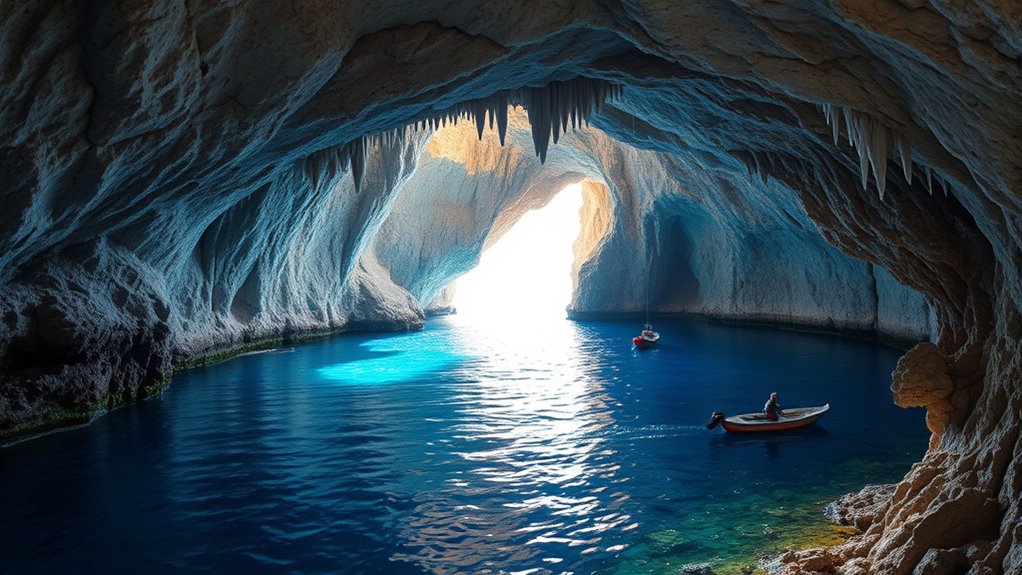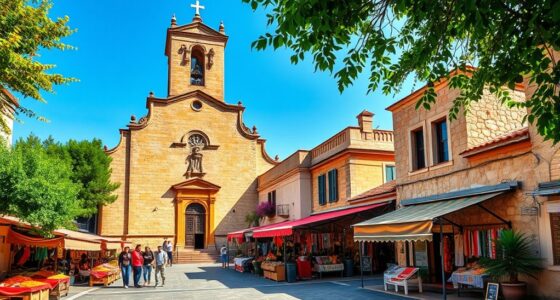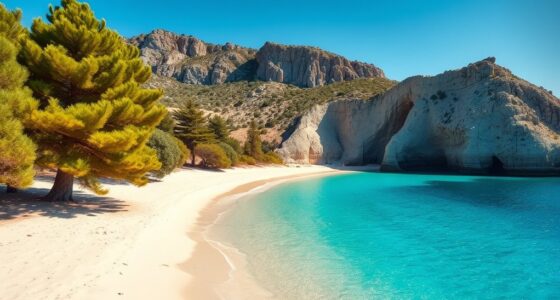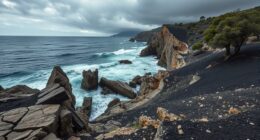Exploring the Grotta di Nettuno is an unforgettable adventure where you can admire stunning stalactites, stalagmites, and an underground saltwater lake. You can reach the cave by boat or take the scenic staircase descending from Capo Caccia. Inside, you’ll discover impressive chambers, pebble beaches, and vibrant mineral formations. As you explore this ancient sea cave, you’ll uncover its geological and historical secrets. Keep going to uncover more fascinating details about this incredible natural wonder.
Key Takeaways
- The Grotta di Nettuno is accessible by boat or via the 654-step Escala del Cabirol from Capo Caccia.
- Inside, visitors can see stunning stalactites, stalagmites, and the underground Lake La Marmora.
- Guided tours often include visits to the pebble beach and underground chambers with impressive formations.
- The cave is part of a protected marine area, requiring responsible tourism and adherence to conservation rules.
- Best visiting times are early mornings or late afternoons to enjoy the cave’s natural beauty with fewer crowds.
Discovering the Hidden Entrance of the Cave
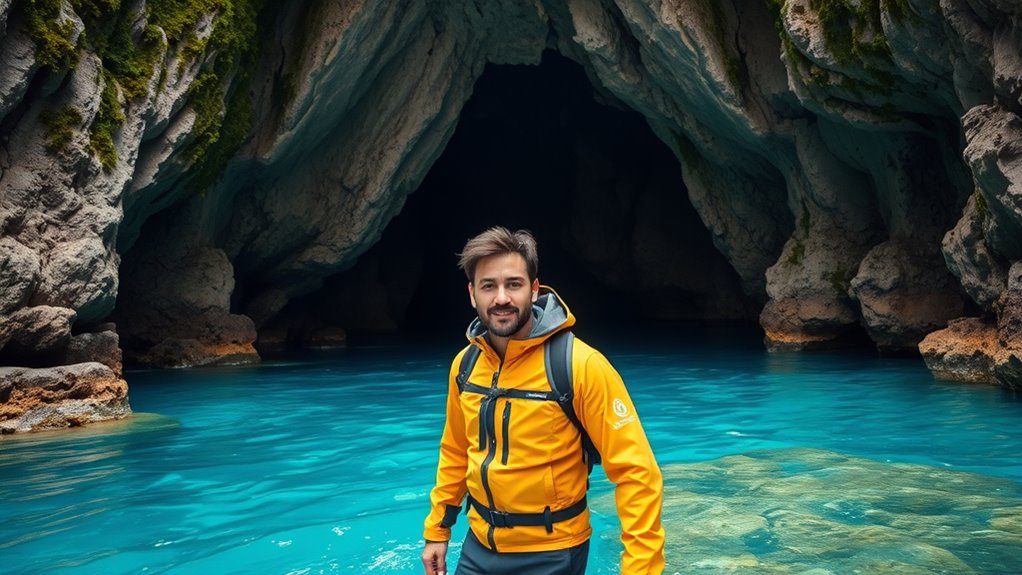
Hidden beneath the towering cliffs of Capo Caccia, the entrance to Grotta di Nettuno remains a secret tucked close to sea level. The cave’s narrow, low-lying opening sits just about one meter above the waterline, blending seamlessly into the rugged limestone cliffs. This strategic placement makes the entrance feel like a hidden portal to an underwater world, especially when the Mediterranean waters are calm. The cliffs rise approximately 110 meters above sea level, framing the cave perfectly against the sea’s backdrop. Historically, fishermen, pirates, and explorers discovered this secret spot, often seeking refuge or shelter. Today, the entrance’s secluded location and dramatic setting continue to evoke a sense of mystery, attracting visitors enthusiastic to experience this concealed natural wonder. Discovered by local fishermen in the 18th century, and its mythological naming after Neptune adds to its allure. Recognizing the geological significance of such formations enhances appreciation for the cave’s unique landscape.
Navigating the Spectacular Interior Formations
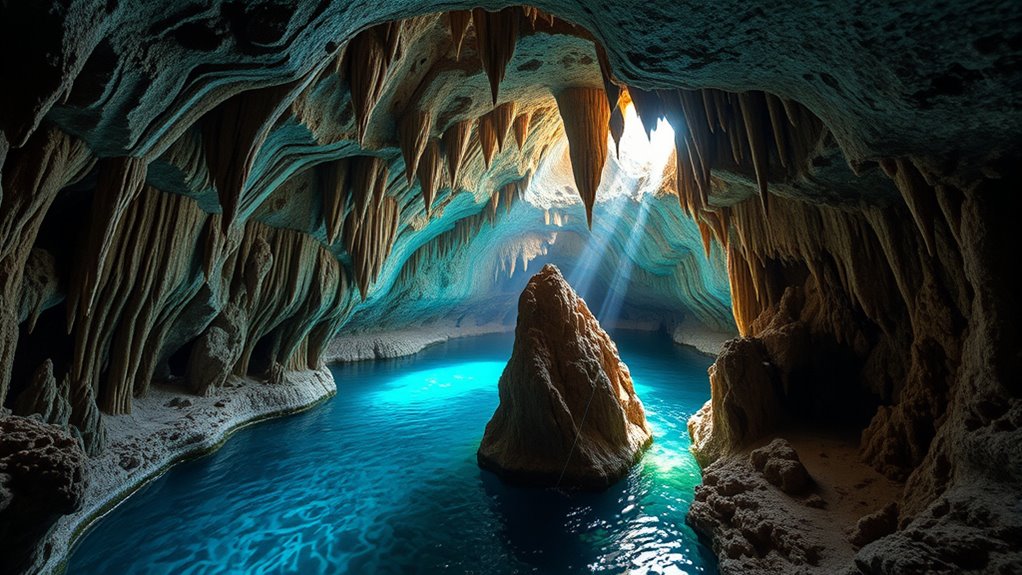
As you explore the cave’s interior, you’ll encounter stunning stalactite and stalagmite displays that have formed over thousands of years. The unique environment showcases a vivid array of colors and intricate structures, creating a mesmerizing natural sculpture gallery. Traveling through these formations lets you witness a remarkable intersection of geology and natural artistry. These formations develop very slowly, with stalagmites taking about 200 years per cubic centimeter and stalactites approximately 100 years, highlighting the patience and natural processes involved in their creation. The color accuracy of these formations depends on mineral content and lighting conditions, adding to their visual appeal.
Stunning Stalactite and Stalagmite Displays
The interior of Grotta di Nettuno showcases an extraordinary array of stalactites and stalagmites that seem to defy time itself. As water drips from the ceiling, minerals like calcium bicarbonate build up, slowly forming these striking structures. Stalactites grow downward, while stalagmites rise from the floor beneath, often meeting to create stunning columns. It takes about 100 years to form just one cubic centimeter of stalactite, and twice that for stalagmites, highlighting their slow, natural evolution. Some formations, like the Acquasantiera and the Christmas Tree, resemble natural sculptures, adding a magical touch. The formations’ intricate patterns and diverse shapes create a landscape that feels alive, emphasizing the cave’s natural artistry and geological history. Additionally, the interplay of light and mineral deposits accentuates the geological processes, revealing the cave’s complex formation history over thousands of years.
Unique Cave Interior Environment
Walking through Grotta di Nettuno’s interior is like entering a living museum of geological artistry. The cave’s dynamic environment features spectacular formations shaped by millions of years of erosion and mineral deposits. You’ll see large columns where stalactites and stalagmites have fused, creating natural pillars. Unique dome-shaped ceilings emerge from joined stalagmites, offering an expansive sense of space. The cave houses Lake La Marmora, with crystal-clear, reflective waters that highlight delicate formations and reveal fossil pebble beaches—testaments to sea level changes over time. The cave’s mineral diversity adds vibrant colors, from white to amber and pink. This environment continually evolves through natural processes, making each visit a glimpse into a living, breathing geological masterpiece. The ongoing mineral deposition and erosion demonstrate the dynamic geological processes that continue to shape the cave today.
The Unique Underground Lake and Sandy Beach
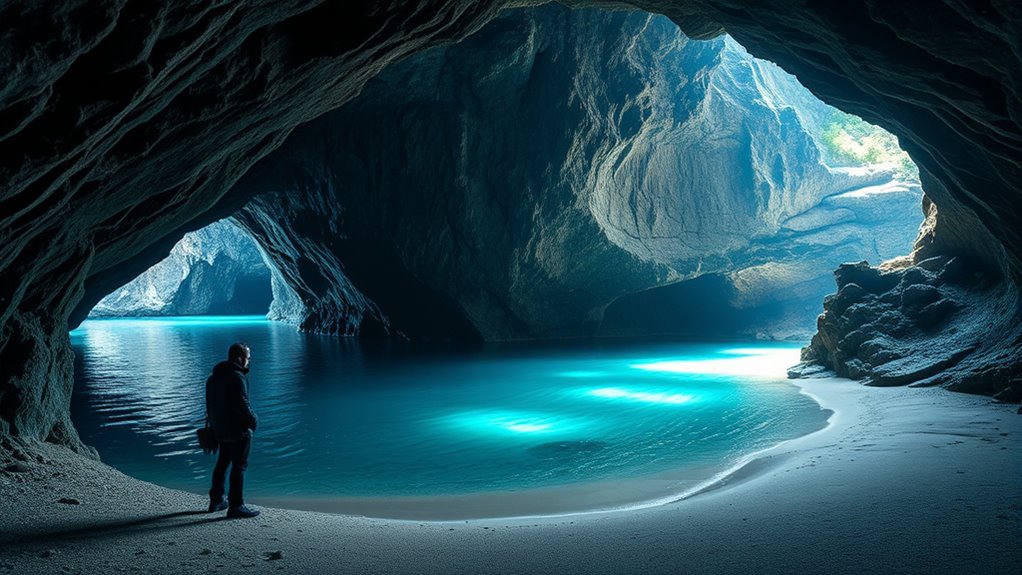
Beneath the limestone formations of Grotta di Nettuno lies La Marmora Lake, one of Europe’s largest underground saltwater basins. It stretches roughly 100 meters long and 25 meters wide, with a depth of about 9 meters. Surrounded by stalactites, stalagmites, and limestone formations, the lake creates a striking contrast against the cave’s rocky interior. A prominent feature is the “Acquasantiera,” a two-meter-tall stalagmite column that acts as a natural water reservoir, providing fresh water for local birds. Inside the grotto, there’s also a pebble beach—an unusual natural shoreline within the cave—offering a peaceful resting spot. Access to the lake and beach is limited to guided tours, highlighting their ecological importance and unique geological features, which emphasize the cave’s significance within this subterranean environment. La Marmora Lake is also notable for its vibrant reflections and natural lighting, which enhance its magical appearance during visits.
Exploring the Horizontal Cave System
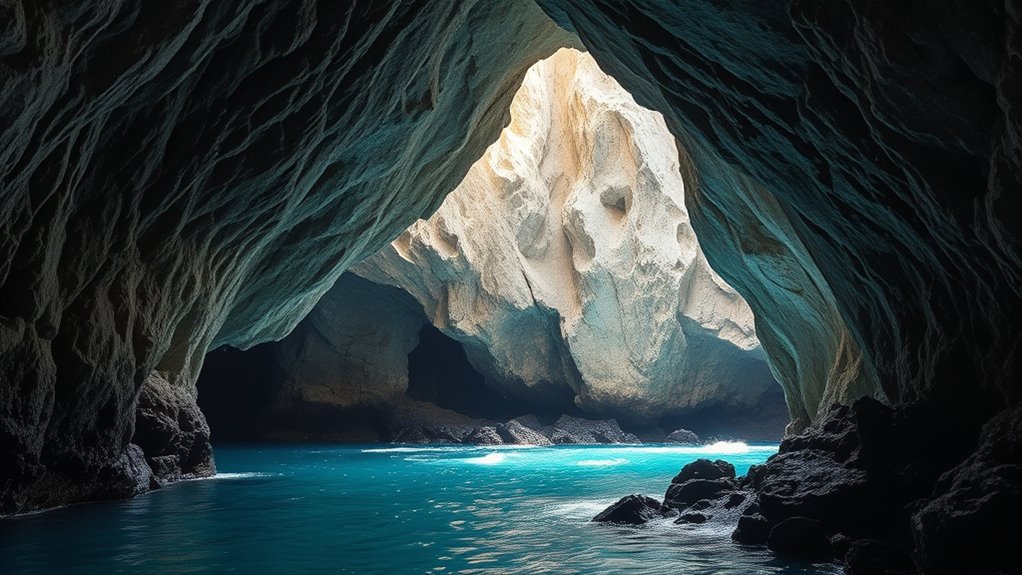
Stretching horizontally for about four kilometers beneath Capo Caccia, the Grotta di Nettuno features an extensive system of tunnels and chambers that reveal the cave’s complex geological history. This vast network is part of a larger karst system extending approximately 70 kilometers underground in the Codula di Luna area. The cave splits into a closed northern “fossil” branch and an open southern section accessible to visitors. Large natural halls formed over millions of years by the merging of smaller cavities showcase impressive formations like stalactites and stalagmites. Created through chemical dissolution and mechanical erosion, these passages contain highlights such as the “Sala delle Rovine” with its 18-meter-high column and the sandy beach along an underground lake. Guided tours explore about a kilometer of southern tunnels, revealing the cave’s breathtaking horizontal development. Chemical dissolution played a key role in shaping the cave’s intricate formations and passages.
Visiting the Surrounding Natural and Archaeological Sites
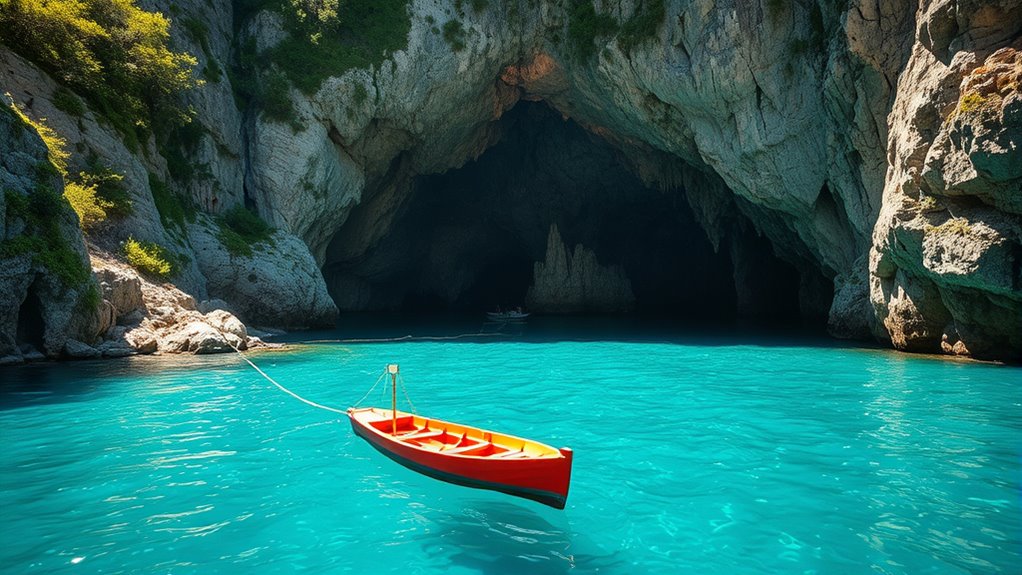
As you explore the area around Grotta di Nettuno, you’ll find fascinating archaeological sites like Nuragic complexes and ancient Roman ruins waiting to be discovered. You can also enjoy scenic coastal trails that connect these cultural landmarks with stunning natural vistas. Don’t miss the chance to experience the vibrant marine ecosystem through boat trips or snorkeling along the protected waters. The promontory of Capo Caccia offers high cliffs and a lighthouse at the peak, providing breathtaking views and additional points of interest. Exploring natural environments such as these can enhance your understanding of the area’s rich history and ecology.
Nearby Nuragic Sites
Exploring the area around Grotta di Nettuno reveals a wealth of Nuragic sites that offer a fascinating glimpse into Sardinia’s prehistoric past. Near Dorgali, you can visit the Nuragic Complex of Barì, which features nuraghi, tombs of the giants, and ancient villages, providing insight into early Sardinian life. In Arzachena, Nuraghe Albucciu offers panoramic views of the surrounding landscape, while Nuraghe Losa near Abbasanta impresses with its well-preserved chambers and architecture. To the north, Nuraghe Santu Antine near Torralba stands out for its size and complexity. The UNESCO-listed Su Nuraxi di Barumini showcases Sardinia’s rich nuragic heritage with its intricate stone structures. These sites collectively reveal the social, ritual, and defensive aspects of Nuragic civilization, highlighting the cultural significance of Sardinia’s archaeological heritage. Each site showcases different aspects of Nuragic architecture and cultural significance, making the exploration of Sardinia’s archaeological landscape a truly enriching experience.
Coastal Nature Trails
The coastal nature trails around Grotta di Nettuno offer an exceptional way to experience the stunning Mediterranean landscape and its rich cultural history. As you walk these trails, you’ll enjoy panoramic views of cliffs, sea stacks, and caves. Some routes lead directly to Grotta di Nettuno’s entrance, accessible by climbing down 654 steps or boat. The trails pass by historical sites like Torre del Tramariglio and ancient maritime structures, connecting you to Sardinia’s past. You can also explore nearby beaches for swimming or snorkeling. Whether you’re a casual walker or an experienced hiker, these paths provide diverse experiences. Parking is available near trailheads, but weather conditions influence access, especially for boat trips and grotto visits. Knowing the operating hours of local attractions can help you better plan your visit to these natural sites.
Marine Ecosystem Highlights
Did you know that the waters surrounding Grotta di Nettuno host an incredible diversity of marine life and unique habitats? As you explore, you’ll notice the rich species variety supported by the nearby Marine Protected Area of Capo Caccia, which safeguards countless Mediterranean species. The caves and surrounding waters create specialized habitats for fish, invertebrates, and rare organisms like the sponge Petrobiona massiliana, often found in similar caves. Conservation efforts guarantee these ecosystems thrive, protecting fragile environments and promoting biodiversity. This area is also part of the Pelagos Sanctuary, an international Italian-French marine protected area dedicated to the conservation of marine mammals. Nearby sites like Isola Piana and Porto Conte Bay further enrich this vibrant marine landscape, offering a glimpse into the region’s ecological richness. These protected zones are essential for research, education, and preserving the natural beauty that makes Grotta di Nettuno so extraordinary. Additionally, sustainable management of these habitats ensures the ongoing health of these ecosystems, emphasizing the importance of marine conservation in maintaining biodiversity.
How to Reach the Grotto: Land and Sea Routes
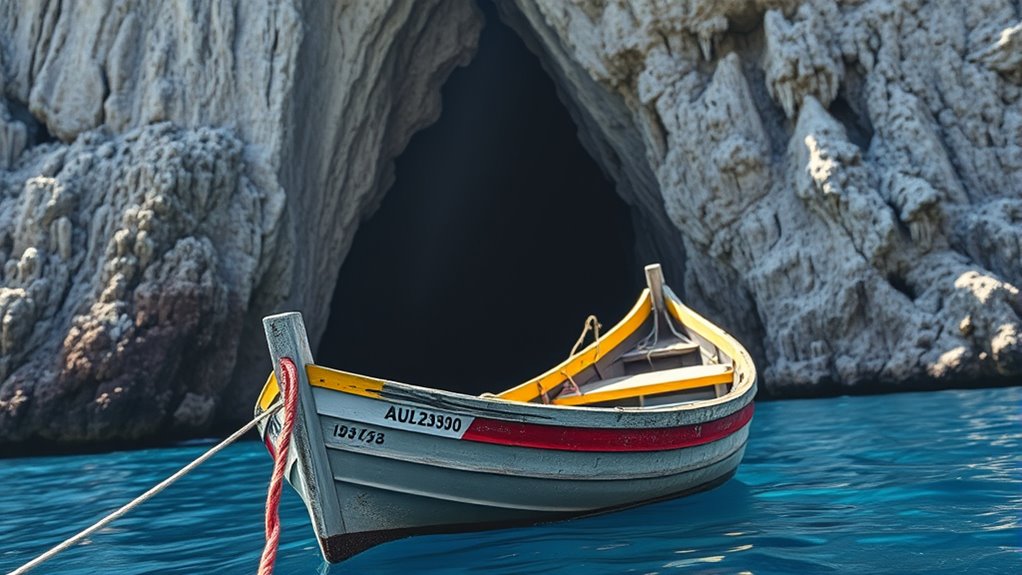
To reach Neptune’s Grotto, you can choose between a scenic boat ride from Alghero’s port or a challenging land route up the cliffside stairs. The boat trip offers stunning coastal views and takes about 40 minutes, departing from Banchina Dogana pier. Keep in mind, sea conditions can affect availability and safety. Alternatively, you can drive from Alghero to Capo Caccia in 30-40 minutes, then descend the Escala del Cabirol’s 654 steps to the grotto entrance. The staircase provides panoramic vistas but demands physical effort and may close due to weather.
| Method | Highlights | Considerations |
|---|---|---|
| Sea Route | Scenic, close to cave entrance, 40 min | Weather-dependent, safety precautions |
| Land Route | Accessible year-round, panoramic views | Physically demanding, staircase risk |
Best Times to Experience the Grotto
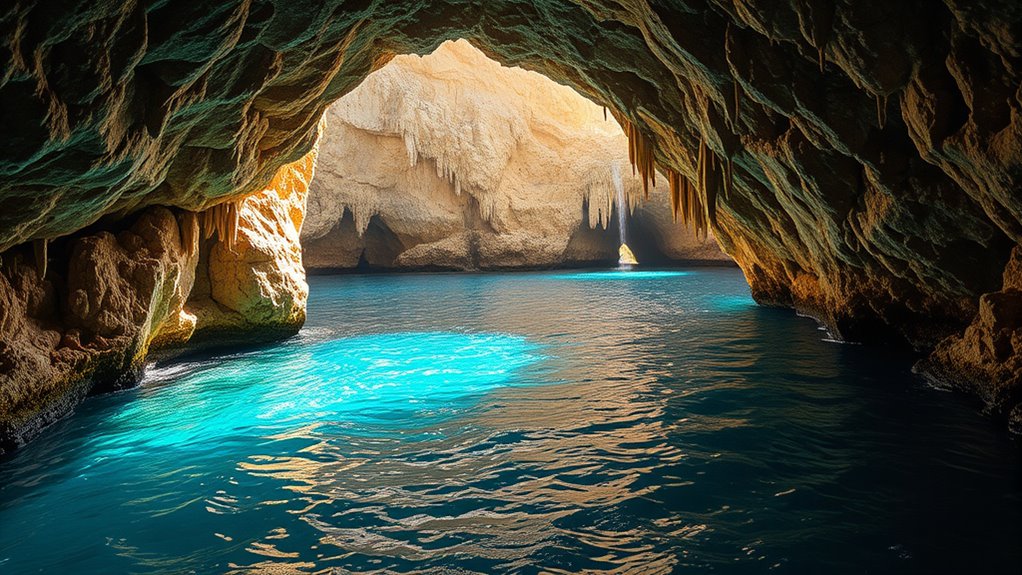
Timing your visit to Grotta di Nettuno depends heavily on weather and sea conditions, especially if you’re planning to arrive by boat. Safe access relies on favorable sea and weather, so check official updates before your trip. Early mornings (around 9 AM) often feature calmer waters and softer light inside the cave, ideal for a peaceful experience. Late afternoons can offer dramatic lighting effects, enhancing the cave’s interior formations. Weekdays outside holidays tend to be less crowded, providing a more relaxed visit. Shoulder seasons like spring and autumn usually offer moderate temperatures and fewer tourists. During peak summer months, mid-morning to late afternoon are the busiest times, so booking in advance is highly recommended. Be flexible and monitor weather conditions for the best experience. The cave is open daily in favorable weather and sea conditions, except December 24-25, so it’s important to verify the operational status before planning your trip.
Conservation Efforts and Responsible Tourism
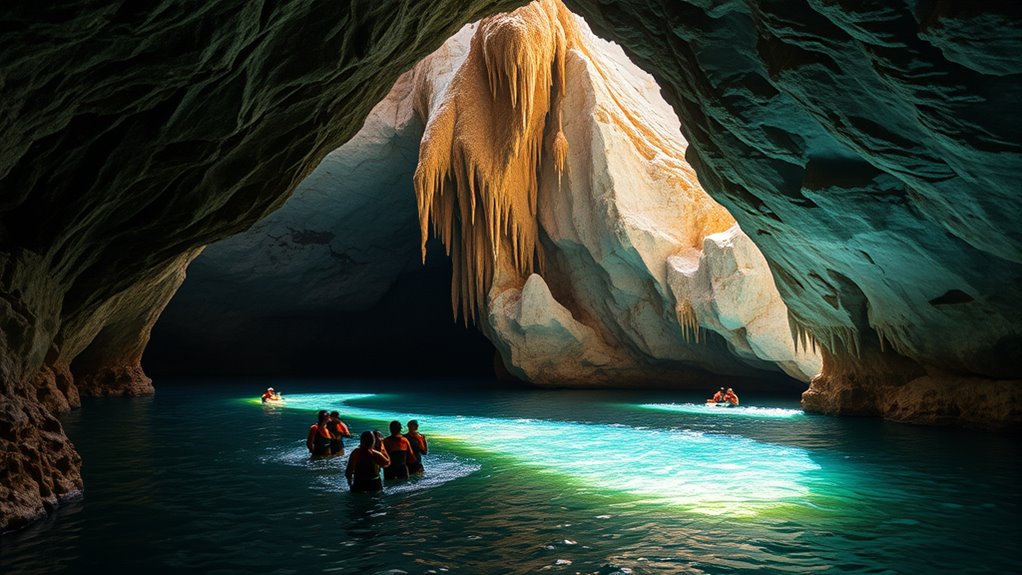
Understanding the importance of protecting Grotta di Nettuno, authorities have implemented strict conservation measures within the Regional Natural Park of Porto Cagliari and the Marine Protected Area of Capo Caccia and Isola Piana. These protections help preserve the cave’s geological features, biodiversity, and marine habitats. To minimize human impact, visitor access is carefully regulated through designated pathways and limited entry. You’ll find that:
Protecting Grotta di Nettuno ensures its natural beauty and biodiversity for future generations.
- Visitor numbers are restricted to prevent overcrowding
- Entry is controlled via boat tours or the Escala del Cabirol stairs
- Educational programs promote responsible behavior
- Fees support ongoing conservation efforts
- Community involvement ensures local stewardship of the site
These combined efforts foster sustainable tourism, ensuring the cave’s natural and cultural heritage remains intact for future generations.
Practical Tips for an Unforgettable Visit
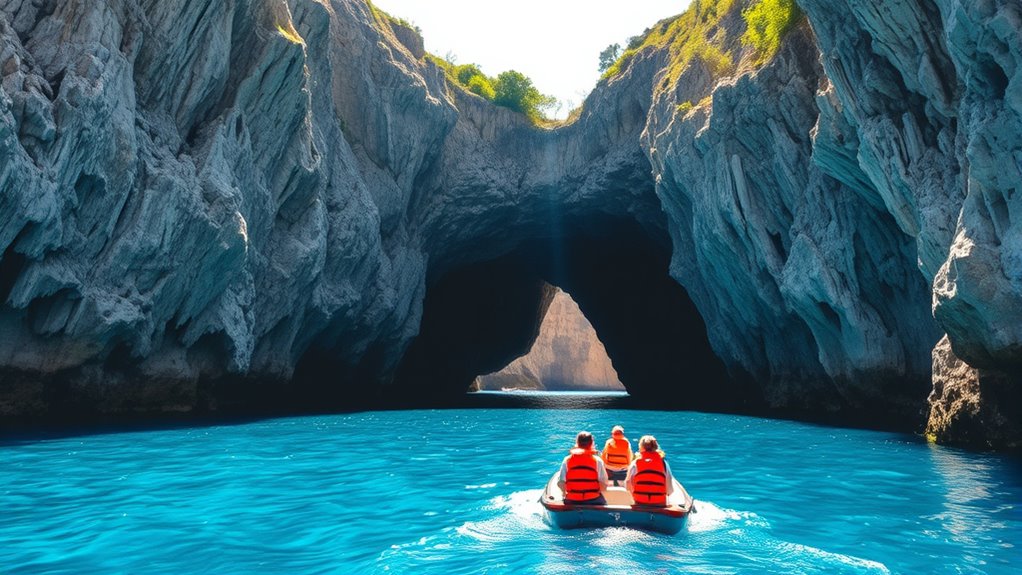
Starting on a visit to Grotta di Nettuno requires some preparation to make your experience truly unforgettable. First, be ready for the steep climb down the Escala del Cabirol, with 654 steps that demand good fitness. Wear comfortable, non-slip footwear to navigate slippery and uneven surfaces inside the cave. Arrive early to allow time for the boat transfer or stair climb and to avoid crowds; tours run from 10:00 AM to 3:00 PM. Book tickets in advance during peak season. Dress appropriately for the cool interior, and bring water and a light snack, as facilities inside are unavailable. Capture photos carefully, avoiding flash to protect formations. Finally, listen attentively to your guide’s explanations to fully appreciate the cave’s natural beauty and history.
Frequently Asked Questions
Is Swimming Allowed Inside the Grotta Di Nettuno?
You’re wondering if swimming is permitted inside Grotta di Nettuno. Swimming isn’t allowed inside the cave because it’s protected, and guided tours are designed for foot exploration only. You can swim in nearby waters like Alghero bay and near Capo Caccia cliffs, but never inside the cave itself. This rule helps preserve the delicate environment and ensures everyone’s safety, so enjoy the land-based tour and the beautiful surroundings instead.
Are There Any Guided Tours Available in the Cave?
You’re asking if guided tours are available inside the cave. Yes, they are! Guided tours start every full hour during opening hours and last about 30 minutes. You can join a walking tour inside the cave to see stalactites, stalagmites, and the saltwater lake. Tours include both land and boat options, but remember to book in advance, arrive on time, and check weather conditions for a smooth experience.
Can Visitors Access the Cave During Bad Weather?
You can’t access the cave during bad weather. When seas are rough or winds are strong, tours are canceled, and access is restricted for safety. Boat trips are automatically rescheduled or refunded if canceled, and land routes may close. Always check official weather updates before planning your visit. During storms, the internal environment can be unsafe, so it’s best to wait until conditions improve for a safe and enjoyable experience.
Are There Age Restrictions for Visiting the Grotto?
You might wonder if there are age restrictions for visiting the grotto. While there’s no strict minimum age, young children under 7 often get free entry, and kids aged 7 to 14 pay a reduced fee. However, consider their physical stamina and safety, especially with the many stairs and boat rides involved. Guided tours are recommended for all ages, ensuring safety and understanding of the site.
Is Photography Permitted Inside the Cave?
You’ll find that photography is permitted inside the cave, giving you the chance to capture its stunning formations and reflections. During guided tours, you can take plenty of photos, but keep in mind that flash might be restricted, and equipment like tripods could require permission. Be respectful of other visitors, move quickly, and wear slip-resistant shoes to ensure safety and preserve the environment while snapping your shots.
Conclusion
Visiting the Grotta di Nettuno offers an unforgettable adventure, revealing hidden wonders beneath the sea. As you explore its stunning formations and secret passages, you’ll feel connected to a timeless natural marvel. Many believe the cave’s origins are linked to ancient myths, adding a touch of mystery to your journey. With responsible tourism, you help preserve this extraordinary site for future explorers. So, plunge in and let this legendary cave leave a lasting impression on you.
